


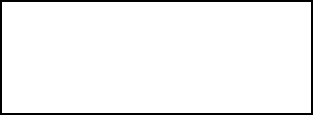



Australian and NZ Fire Brigades
Official Position Statement
Published: 01 June, 2006
FACT: Since 1993, Australian Government scientific test data shows ionization smoke alarms have failed to
activate until “dangerously high” and “totally unacceptable” levels of smoke.
FACT: New legislation in some US states and cities mandates photoelectric smoke alarms.
FACT: After extensive scientific research, the official position of all Australian and New Zealand Fire Brigades
is, “That ALL residential accommodation be fitted with PHOTOELECTRIC smoke alarms.”
FACT: The International Association of FireFighters (292,000 members) official position states photoelectric
smoke alarms, “. . . will drastically reduce the loss of life among citizens and fire fighters . . .”
FACT: U.S. Federal court judges recently declared ionization smoke detectors as "defectively designed"
and their failure to be “a legal cause of deaths” (Hackert v First Alert, Inc. & BRK Brands, Inc. March, 2008)
FACT: Standards Australia has closed the deadly loophole in Australia’s Smoke Alarm Standard (AS3786).
As at April 2010, the ABCB is still refusing to adopt this critical amendment into the Building Code of
Australia which continues to put lives at needless risk.
FACT: The Australasian Fire and Emergency Services Authority Council (AFAC) and Fire Protection Association
Australia (FPAA) have formally identified performance problems with ionization smoke alarms.
“That ALL residential accommodation be
fitted with PHOTOELECTRIC smoke alarms.”
David Isaac
Member Standards Australia
Committee FP2
Graham Huxley AM
Chairman, ABCB

“Fire-fighters haven't been told the truth.
Watch 'Smoke Alarm Recall' and see the
facts about ionization alarms for yourself.”

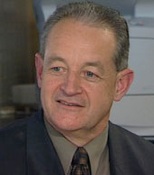
“Ionization smoke alarms are dangerous because
they lull people into a false sense of security when
cooking toast but often fail in smouldering fires.”
David Isaac after discovering the ‘Deadly Loophole’ with the testing
of ionization alarm's in Australia's Smoke Alarm Standard (AS3786)
Tracy Grimshaw,
Peter Cannon
Urging fire-fighters
to find out the facts
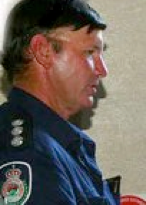
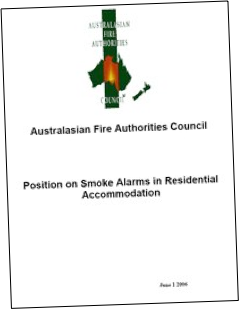



In February 2007 the World Fire Safety Foundation sent ‘The CAN Report’
by registered mail, to all ABCB Board Members. This report explains the legal
and scientific case against ionization alarms.
The report supported Standard Australia's second attempt to have the ABCB
adopt the corrected smoke alarm standard which will effectively mandate photoelectric smoke alarms in all new Australian and New Zealand homes.
In March 2007, despite overwhelming evidence, the ABCB replied (see below)
stating the problem was “...not clear to the Board...”
. . . So why, in 2010 is the Australian Building
Codes Board (ABCB) STILL putting lives at risk
by continuing to block the corrected standard?
The Failure to Close Australia’s ‘Deadly Loophole’

Australasian Fire Authorities Council (AFAC) Official Position on Smoke Alarms in all
Australian & New Zealand Homes - 01 June, 2006, page 3, clause 3 (emphasis added)
The Volunteer Fire Fighter Association Magazines
Warning Fire Fighters about ionization alarms

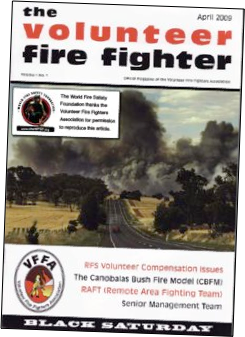
Peter Cannon, President, Volunteer Fire
Fighters Association. August 2008
Download
Word Doc
The Sample ‘Please Explain’ Letter
Last Updated: 10 Jan, 2010 | for use in Australia and N.Z. only
There are two different type of smoke alarms, ionization (in almost every home) and photoelectric (in commercial buildings). Testing to the
specifications of the current Australian Smoke Alarm Standard (AS3786) requires that ionization smoke alarms have to pass a test for invisible
particles of combustion (sometime referred to as ‘invisible smoke’), while photoelectric alarms have to pass a test for visible smoke.
However, both types of smoke alarms are subjected to the test for visible smoke and AS3786 has been (mis)interpreted such that Ionization smoke alarms do not have to pass the test for visible smoke. Test data since 1993 shows ionization smoke alarms are unable to pass the test for visible smoke because they fail to activate until more than twice the maximum safe limit set for photoelectrics.
This deadly loophole has now been closed in the corrected, draft Standard. This means all ionization smoke alarms will now have to pass the test for smoke (which CSIRO test data shows they are unable to do), once the corrected Standard becomes law. However, the corrected Standard
must be adopted into the Building Code of Australia by the Australian Building Codes Board before it becomes law.
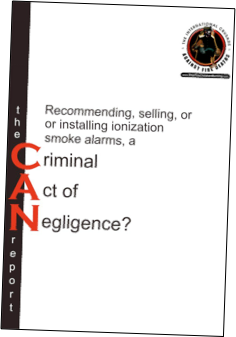
The CAN Report
Sent to ALL ABCB Board Members - Feb 2007
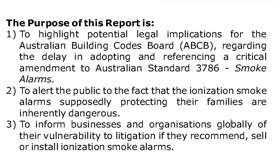
“The smoke alarm shall be designed to
respond reliably to the presence of smoke.”
AS3786-1993 - Smoke Alarms, page 7, clause 2.1
ionization alarms do not detect visible smoke.
Stated by the CSIRO after the deadly loophole in the Australian Smoke Alarm standard was discovered.

“What we discovered to our horror . . . is that ionization smoke alarms are
allowed to go to 50 - 60% [smoke] . . . Dangerously High, Totally Unacceptable!”
David Isaac, Member Standard Australia Committee FP-002, The CAN Report, Feb 2007
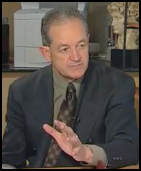

Ionization Alarms - Proven Unsafe . . .
Feb 2007, Appendix A, page 8, para 4..
from Standard Australia’s second request to the ABCB to
close the ‘Deadly Loophole’ and adopt the corrected Standard.

Karl Westwell
CEO, WFSF
The ABCB Emails, Open Letters &
Freedom of Information Act Application
The Australian Standard states that . . .
. . . but CSIRO scientific test data shows

The Australian Building Codes Board continues to put Australian & New Zealand Lives at Needless Risk
We Need YOUR Help
Please send this sample ‘Please Explain’ letter to the ABCB - Thank You!
W A R N I N G!
The ABCB refused to adopt the critical amendment to Australia’s flawed smoke alarm standard. However, once informed about the known and deadly defects inherent in ionization smoke alarms, ‘Prior Knowledge’ and a ‘Duty of Care‘ exists to correct and adopt the flawed Standard.
“It turns out the vast majority of us have the
wrong type of smoke alarms fitted in our homes.”
Tracy Grimshaw, when the Aquarium Test and AFAC's
Official Position were on national Australian TV. June 2006

Tracy Grimshaw
Warning Australians
about ionization alarms


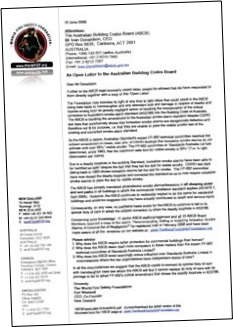
‘The CAN Report’ - Extract (page 8, para 1)
Consider the Evidence:



Formal requests for ABCB transparency and accountability
16 June, 2009 | 26 January, 2010 | 13 April, 2010 | 29 April, 2010
“Why does the ABCB deem itself more competent in these matters than the
expert FP-002 technical committee
of Standards Australia Limited?”
“It is not clear to the Board, from the evidence
available, that ionization detectors do not
achieve the level of performance required for
warning occupants . . .”
ABCB response to the ’The CAN Report’, March 2007
See The first ‘ABCB Open Letter’ sent by the WFSF
to the ABCB and their legal counsel June, 2009

Download
PDF
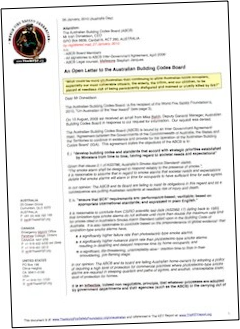

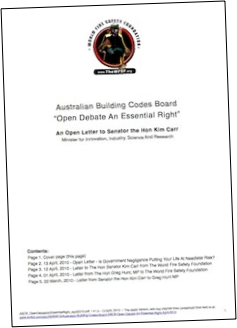
Has ‘Scientific Misconduct’ been Committed with the
Standards Testing of Ionization Smoke Alarms in Australia?
Why is the Australian Building Codes Board (ABCB) still blocking the closing of
the ‘Deadly Loophole’ in Australia’s Smoke Alarm Standard despite Australian Government scientific test data (since 1993) proving ionization smoke alarms are not fit-for-purpose*?
(*because they do NOT safely detect fire in the earliest, most critical, ‘smouldering’ stage)
See below . . .
Has ‘Scientific Misconduct’ been committed with the Standards
Testing of Ionization Smoke Alarms in the U.S.A.? More > > >
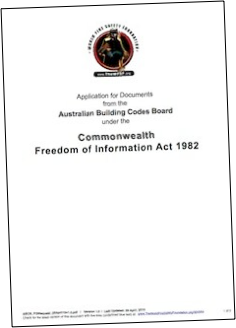
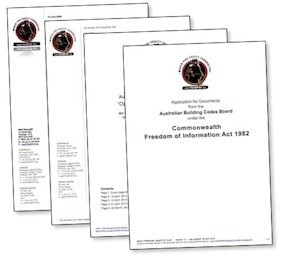
ABCB Open Letters and
Freedom of Information Act Application



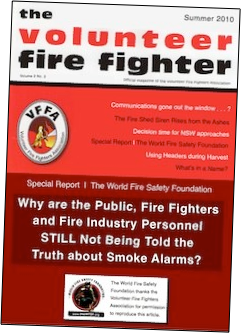

(c) Copyright 2010 The World Fire Safety Foundation | Last Updated: 07 October, 2011 | Privacy Policy | Disclaimer | Search WFSF site
For errors on, or suggestions for this ‘abcb’ webpage, contact the WFSF WebMaster | Supporters | About | Media